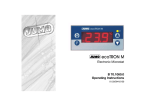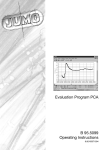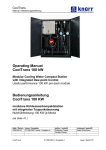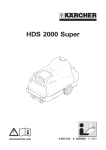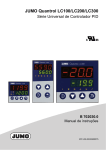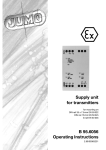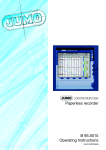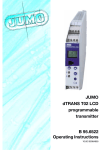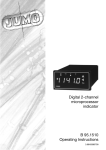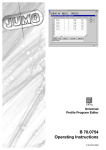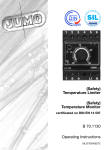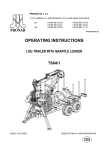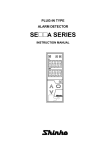Download (Safety) Temperature limiter (Safety) Temperature monitor B
Transcript
(Safety) Temperature limiter (Safety) Temperature monitor to DIN 3440 B 70.1130 Operating Instructions Version 1 / 8.98 / 00354358 Conformance symbol The instrument conforms with the requirements of DIN 3440. H If any servicing is required, the instrument must be returned to the main factory. In accordance with the recommendations of Germanische Lloyd, specific applications require the availability of a replacement instrument. 1 B Please read these Operating Instructions before commissioning the instrument. Keep the operating instructions in a place which is accessible to all users at all times. Please assist us to improve these operating instructions, where necessary. We are always grateful for your suggestions. Phone in Germany from abroad Fax in Germany from abroad H (06 61) 6003-727 (+49)661 6003-0 (06 61) 60 03-5 08 (+49) 661 6003-607 Should any difficulties arise during start-up, you are asked not to carry out any unauthorised manipulations on the instrument. You could endanger your rights under the warranty! Please contact the nearest JUMO office or the main factory. 2 x 3 Contents 1 Introduction 1.1 1.2 1.3 1.4 Description ..........................................................................5 Block structure ....................................................................6 Type designation ................................................................7 Registration number ...........................................................8 2 Installation 2.1 2.2 2.3 2.4 Location and climatic conditions ........................................9 Dimensions .........................................................................9 Mounting on a standard rail or a mounting plate ...........................................................10 Removal ............................................................................11 3 Electrical connection 3.1 3.2 3.3 Installation notes ...............................................................12 Connection diagram .........................................................13 Lead compensation ..........................................................14 4 Function 4.1 4.2 4.3 Indication and controls .....................................................15 O-function .........................................................................16 S-function .........................................................................17 5 Starting up 6 Functional test 6.1 6.2 Test frequency ..................................................................19 Testing STBs and STWs with O-function when thermocouples are connected ................................20 Testing STBs and STWs with S-function when thermocouples are connected ................................22 Testing STBs and STWs with O- or S-function when connecting resistance thermometers ....25 6.3 6.4 7 Test in the event of a fault 8 Technical data x 1 Introduction 1.1 Description The areas of application for (safety) temperature limiters or monitors ((S)TB or (S)TW) are to be found wherever thermal processes have to be monitored, and where the system must be set to a safe operating condition in the event of a fault. If the permitted temperature limit is reached, or a fault occurs within the permitted temperature range (probe break/short-circuit, component defect, power failure), then the instrument switches off without delay. If the fault is no longer present, then TB and STB must be reset manually. This can be done by means of a reset pushbutton on the instrument, or by an external reset button. The flow of energy is only enabled again when the temperature is lower (O-function) or higher (S-function) than the preset limit temperature by the amount of the switching differential. In the event of a short-term power failure (≤ 1min) within the satisfactory range of the system, the instrument is enabled automatically after the power has been restored. The amount of the switching differential is 3°C, 10°C, 30°C or 100°C. The analogue limit setting knob for the limit temperature is mounted on the front panel. An unintentional or unauthorised adjustment of the limit setting is prevented by a clear cover which can be leadsealed. The instruments are intended for use as built-in units for fixing onto standard rails to EN 50022-35. The screw terminals for the electrical connection (max. conductor cross-section 2.5mm2) are on one wiring level. The instruments function over defined temperature ranges between 0 and 2000 °C. Temperature monitor TW* Temperature monitors are devices which, after cutting out, are automatically reset when the probe temperature has fallen below the preset limit value by the amount of the switching differential. Safety temperature monitor STW* Safety temperature monitors are temperature monitors which, in addition, meet the requirements for enhanced safety to DIN 3440. 5 1 Introduction Temperature limiter TB* Temperature limiters are devices which are locked out after cutting out. They can be reset, either manually or by means of a tool, when the probe temperature has fallen below the limit value by the amount of the switching differential. Safety temperature limiter STB* Safety temperature limiters are temperature limiters which, in addition, comply with the requirements for enhanced safety according to DIN 3440. * Extract from DIN 3440 1.2 Block structure 6 1 Introduction 1.3 Type designation (1) 701130 / **** (2) – *** (3) – ** (4) / *** (1) Basic type extensions 0151 Temperature monitor with O-function 0152 Temperature monitor with S-function 0153 Temperature limiter with O-function 0154 Temperature limiter with S-function 0251 Safety temperature monitor with O-function 0252 Safety temperature monitor with S-function 0253 Safety temperature limiter with O-function 0254 Safety temperature limiter with S-function (2) Measurement inputs 001 Resistance thermometer Pt100 in 2-wire circuit 037 W3Re-W25Re 042 Fe-Con L 043 NiCr-Ni K 044 Pt10Rh-Pt S 046 Pt30Rh-Pt6Rh B 7 1 Introduction (3) Supply 02 230V AC, +10% / -15% 48—63Hz 05 08 115V AC, +10% / -15% 48—63Hz 24V AC, +10% / -15% 48—63Hz (4) Extra Codes 202 205 Switching differential 3°C (only for Pt100) Switching differential 10°C 206 Switching differential 30°C 208 229 Switching differential 100°C 231 Lead resistance 10Ω internally compensated* 233 Lead resistance 30Ω internally compensated* 235 Lead resistance 50Ω internally compensated* Internal reset button (extra Code with TB only) GL 245 062 Lead resistance 1Ω internally compensated* * Lead compensation resistor LAW (10Ω) is included in the delivery Accessories External reset button RT Sales No. 70/97097865 Mounting plate BS Sales No. 70/00059172 Lead compensation resistor LAW (10Ω) Sales No. 70/00322800 1.4 Registration number For Type 701130/... : TB/TW/STB/STW 1091 97 8 2 Installation 2.1 Location and climatic conditions The location and the climatic conditions must meet the requirements defined in the specifications under Technical Data. (v Chapter 8). 2.2 Dimensions 9 2 Installation 2.3 Mounting on a standard rail or a mounting plate The instruments are designed as built-in units and are protected to IP20 as standard. h Insert the instrument from above into the standard rail or into the cut-out of the mounting plate and swing it down until it snaps into position Mounting the GL-version: h Push the fixing elements into the guides on the sides h Insert the unit from above into the rail and swing it down until it snaps into position (as above) h Push the fixing elements up to the rail and tighten them evenly with a spanner. (see diagram on next page!) 10 2 Installation 2.4 Removal h Insert a screwdriver in the direction of the arrow under the clip h Press the clip down and swing the unit up at the same time 11 3 Electrical connection 3.1 Installation notes ■ The requirements of VDE 0100 “Regulations for the installation of power equipment with rated voltages up to 1000V” or the equivalent national regulations must be observed in the choice of cable material, the installation and the electrical connection of the equipment. ■ The electrical connection must only be made by properly qualified personnel. ■ Isolate the instrument on both poles from the supply if there may be contact with live parts during work. ■ The electromagnetic compatibility (EMC) conforms to the standards and regulations listed under Technical Data. v Chapter 8 ■ Sensor, output or supply cables should be routed separately from one another, and not laid in parallel. ■ Sensor cables must be twisted and shielded. Avoid running them close to current-carrying components or cables. ■ Do not connect any additional loads to the supply terminals of the instrument. ■ The instrument is not suitable for installation in hazardous areas. ■ Inductive components in the neighbourhood of the instrument, such as contactors or solenoid valves, must have RC combinations fitted for interference suppression. ■ The approval of the instrument to DIN 3440 is only valid if the temperature probes marked with * in Chapter 8 “Technical Data“ are used. If temperature probes are used which are not marked or listed, then the approval of the instrument and probes must be checked. 12 3 Electrical connection 3.2 Connection diagram The electrical connection must only be carried out by qualified personnel. Connection for Terminals Relay output 7 8 9 common n.o. (make) n.c. (break) Supply as on label L1 N line neutral External reset pushbutton 5 6 Resistance thermometer in 2-wire circuit 1 2 LAW= Lead compensation resistor Thermocouple 1 2 3 4 230V 2A, resistive load – Thermocouple 1 + – Thermocouple 2 + 13 3 Electrical connection 3.3 Lead compensation A lead resistance of 0.5Ω is allowed for internally as standard; 1Ω,10Ω, 30Ω or 50Ω (extra Code) to special order. A lead compensation resistor LAW (10 Ω; included in the delivery package when the appropriate extra Code is ordered) is required for the connection to Pt 100 resistance thermometers with a max. operating temperature of 700°C. Compensation condition: RL = Rcomp + RLF RL internally compensated lead resistance of the measuring circuit Rcomp resistance of the lead compensation resistor LAW resistance of the probe leads RLF 14 4 Function 4.1 Indication and controls Screw terminals, max. 2.5mm2 Reset button (extra Code with TB only) Limit setting knob Limit scale Fault indicator for channel 1 (S1) and channel 2 (S2) S2 only for STB and STW Lead-sealable clear cover Plastic casing 15 4 Function 4.2 O-function Response in normal operation – ϑ < ϑG – temperature rises ⇒ the relay drops out at ϑ = ϑG . Response after rising above the limit – ϑ > ϑG – temperature falls ⇒ the relay pulls in automatically at ϑ = ϑG–Xsd (STW and TW), or has to be reset manually (STB and TB) Response in fault condition In the event of a fault (probe break/short-circuit, faulty electronics, supply failure) the relay drops out. When – the fault has been cleared – ϑ ≤ ϑG–Xsd ⇒ then the relay pulls in automatically (STW and TW). STB and TB must be reset manually. Only in the event of a short-term power failure (≤ 1 min) in the satisfactory range of the system, will the instrument automatically be enabled after the power has been restored. 16 4 Function 4.3 S-function Response in normal operation – ϑ > ϑG – temperature falls ⇒ the relay drops out at ϑ = ϑG . Response after falling below the limit – ϑ < ϑG – temperature rises ⇒ the relay pulls in automatically at ϑ= ϑG+Xsd (STW and TW), or has to be reset manually (STB and TB) Response in fault condition In the event of a fault (probe break/short-circuit, faulty electronics, supply failure) the relay drops out. When – the fault has been cleared – ϑ≥ϑG+Xsd ⇒ then the relay pulls in automatically (STW and TW). STB and TB must be reset manually. Only in the event of a short-term power failure (≤ 1 min) in the satisfactory range of the system, will the instrument automatically be enabled after the power has been restored. 17 5 Starting up The setting of the limit value must not change by itself under operating conditions. A clear cover which is lead-sealable is therefore provided to prevent unintentional or unauthorised adjustment. h Swing the clear cover upwards and remove it. h Set the required limit on the scale using the limit setting knob. The limit setting can easily be read, even when the clear cover is in position. The start and end of the range are fixed by stops. h After setting the limit, carry out the function test (v Chapter 6) and lead-seal the clear cover. H The safety circuit must be reset after every switch-on or break in the mains supply, by using the internal or external reset button (only for TB and STB). Only in the event of a short-term power failure (≤ 1 min) in the satisfactory range of the installation, will the instrument automatically be enabled after the power has been restored. For lead sealing, a hole is provided on each side of the clear cover. A wire is passed through these holes to connect the cover and the casing. The wire ends are secured by a lead seal. 18 6 Functional test 6.1 Test frequency The safety temperature monitors and limiters fulfil the requirements made in Draft DIN 3440 A1 of September 1991. In addition, the instrument must undergo an annual functional test. H Generally, the functional test always starts from the satisfactory range of the system, i.e. the fault signal diodes must not be lit up and the STBs must be reset. It is necessary to short-circuit or open the measurement input circuit(s) for the functional test. The reset button must also be shortcircuited during the test. For a rapid functional test it is therefore recommended that the buttons I, II, and III are included in the measurement or reset circuits. H When connecting themocouples and buttons it is important to ensure that no additional thermal e.m.f occurs (temperature differences at the terminals). When resistance thermometers and buttons are connected, it must be ensured that the contact resistance is not too high. (0.4Ω ≈ 1°C error). . Carry out a functional test after every malfunction! 19 6 Functional test 6.2 Testing STBs and STWs with O-function when thermocouples are connected ✱ Short-circuit the reset button ✱ Simulate a probe break of thermocouple 1: The LEDs S1 and S2 must light up. The external fault indicator must light up. The safety circuit must be opened. The LEDs S1 and S2 must go out after about 5 sec. The external fault indicator remains lit up and the safety circuit remains open. 20 6 Functional test ✱ Remove the short-circuit across the reset button: The LEDs S1 and S2 light up again. The external fault indicator remains on. ✱ Remove the probe break: If the probe temperature is within the permitted temperature range i.e. below the limit setting by the switching differential, then the two LED S1 and S2 must go out after approx. 5 sec. For an STW, the external fault indication must also disappear and the safety circuit must close. For an STB, the external fault indication must continue to be lit up and the safety circuit must remain open. The safety circuit is only closed again when the reset button is pressed. ✱ Repeat the procedure for thermocouple 2. Check response on power failure (STB). In the satisfactory range of the system: ✱ Switch off mains: Wait for approx. 1 min ✱ Switch on mains: The LEDs S1 and S2 must light up for approx. 5 sec and then go out The external fault indicator must go out after a further 2 sec approx. and the safety circuit must close automatically. In the event of a fault: ✱ Simulate a probe break of the thermocouple 1: The LEDs S1 and S2 must light up. ✱ Remove the probe break of thermocouple 1: The LEDs S1 and S2 must go out after about 5 sec. The safety circuit remains open. 21 6 Functional test ✱ Switch off mains for at least 5 sec. ✱ Switch on mains: The LEDs S1 and S2 must light up for about 5 sec and then go out. The external fault indication continues to be lit up and the safety circuit remains open. The safety circuit will only close again, and the external fault indication will go out, when the reset button is pressed. 6.3 Testing STBs and STWs with S-function when thermocouples are connected 22 6 Functional test ✱ Short-circuit the reset button ✱ Simulate a probe short-circuit of thermocouple 1: The LEDs S1 and S2 must light up. The external fault indication must light up. The safety circuit must be open. LEDs S1 and S2 must go out after approx. 5 sec. The external fault indication remains lit and the safety circuit remains open. ✱ Remove short-circuit of reset button: The LEDs S1 and S2 light up again. The external fault indication remains on. ✱ Remove probe short-circuit: If the probe temperature is within the permitted temperature range, i.e. above the limit setting by the switching differential, then the two LEDs S1 and S2 must go out after approx. 5 sec. For an STW, the external fault indication must also disappear and the safety circuit must close. For an STB, the external fault indication must continue to be lit up and the safety circuit must remain open. It will only close again when then reset button is pressed. ✱ Repeat the procedure for thermocouple 2. Check the response after power failure (STB only) In the satisfactory range of the system: ✱ Switch off mains: Wait for approx. 1 min ✱ Switch on mains: The LEDs S1 and S2 must light up for approx. 5 sec and then go out. 23 6 Functional test The external fault indication must go out after a further 2 sec (approx.) and the safety circuit must close automatically. In the event of a fault: ✱ Simulate a probe short-circuit of thermocouple 1: The LEDs S1 and S2 must light up. ✱ Remove the probe short-circuit of thermocouple 1 The LEDs S1 and S2 must go out after approx. 5 sec. The safety circuit remains open. ✱ Switch off mains for at least 5 sec ✱ Switch on mains: The LEDs S1 and S2 must light up for approx. 5 sec and then go out. The external fault indication continues to be lit up and the safety circuit remains open. Only when the reset button is pressed, will the safety circuit close and the external fault indication go out. 24 6 Functional test 6.4 Testing STBs and STWs with O- or S-function when connecting resistance thermometers ✱ Short-circuit the reset button ✱ Simulate a probe break: The LEDs S1 and S2 must light up. The external fault indication must light up. The safety circuit must be open. The LEDs S1 and S2 must go out after approx. 5 sec. 25 6 Functional test The external fault indication continues to be lit up and the safety circuit remains open. ✱ Remove the short-circuit across the reset button: The LEDs S1 and S2 light up again. The external fault indication remains on. ✱ Remove the probe break: If the probe temperature is within the permitted temperature range (i.e. below the limit setting by the switching differential for an O-function, or above the limit setting by the switching differential for an S-function), then the two LEDS S1 and S2 go out after approx. 5 sec. For an STW, the external fault indication must also go out and the safety circuit must close. ✱ For an STB, the external fault indication must continue to be lit up and the safety circuit must remain open. The safety circuit will only close again when the reset button is pressed. ✱ Short-circuit the reset button ✱ Simulate a probe short-circuit: The LEDs S1 and S2 must light up. The LEDs S1 and S2 must go out after approx. 5 sec. ✱ Remove short-circuit across the external reset button: The LEDs S1 and S2 light up again. ✱ Remove the probe short-circuit: If the probe temperature is within the permitted temperature range (i.e. below the limit setting by the switching differential for an O-function, or above the limit setting by the switching differential for an S-function), then the two LEDs S1 and S2 must go out after approx. 5 sec. For an STW, the external fault indication must go out and the safety circuit must close. 26 6 Functional test For an STB, the external fault indication must continue to be lit up and the safety circuit must remain open. It is only closed again when the reset button is pressed. Check response after a power failure (STB) In the satisfactory range of the system: ✱ Switch off mains: Wait approx. 1 min ✱ Switch on mains: The LEDs S1 and S2 must light up for approx. 5 sec and then go out. The external fault indication must go out after (approx.) a further 2 sec and the safety circuit must close automatically. In the event of a fault: ✱ Simulate a probe break: The LEDs S1 and S2 must light up. ✱ Remove the probe break: The LEDs S1 and S2 must go out after approx. 5 sec The safety circuit remains open. ✱ Switch off mains for at least 5 sec ✱ Switch on mains: The LEDs S1 and S2 must light up for approx. 5 sec and then go out. The external fault indication continues to be lit up and the safety circuit remains open. Only when the reset button is pressed, will the safety circuit close and the external fault indication go out. 27 7 Test in the event of a fault In the event of a system fault, the instrument switches off the system. This condition is indicated by LED S1 lighting up (S1 and S2 on instruments with enhanced safety). The fault is signalled simultaneously by the external fault indication. In this condition, the relay of the temperature limiting device (STB, TB, STW, TW) is not operated. Initial condition: STB has switched off the system. Fault indicators are lit Fault indicators are off The fault is still present in the system (over/undertemperature, probe break/short-circuit) h Press the reset button (at least 5 sec) until S1 and S2 go out If the safety circuit remains open, the system and the probe circuit have to be checked. h Press the reset button If the instrument remains inhibited after pressing the reset button, the replacement instrument must be installed and the functional test carried out. 28 8 Technical data Inputs Resistance thermometer Pt100 in 2-wire circuit: 0—120°C* 0—300°C* 0—400°C* 0—600°C* 200—500°C* Ambient temperature error: 0.8°C/10°C Lead compensation: A lead resistance of 0.5Ω is allowed for internally as standard; 1Ω, 10Ω, 30Ω or 50Ω on request. A lead compensation resistor LAW (10Ω) is required for connection to resistance thermometers with a max. operating temperature of 700°C. Double thermocouples NiCr-Ni K: 200— 600°C* 400— 800°C* 600—1000°C* 800—1200°C Pt10Rh-Pt S: 400— 800°C* 800—1200°C* 1000—1400°C 1200—1600°C Pt30Rh-Pt6Rh B: 800—1200°C* 1000—1400°C* 1200—1600°C 1400—1800°C Fe-Con L: 50— 450°C* 200— 600°C* 500— 900°C W3Re-W25Re: 1600— 2000°C Ambient temperature error: 2.0°C/10°C * For temperature probes used in accordance with DIN 3440, the max. limit temperature of the instrument is determined by the upper meas. temperature of the selected temperature probe. 29 8 Technical data Outputs Relay with floating changeover contact Switching capacity: 2 A 230 V AC, resistive load protected by fuse 2A M Contact life: 100.000 switching operations at rated load General data Switching point accuracy ±2% of span Switching differential 3°C (for Pt100 only), 10°C, 30°C or 100°C Supply 230V AC, 115V AC, 24V AC, +10% / -15% 48—63Hz +10% / -15% 48—63Hz +10% / -15% 48—63Hz Power consumption 4 VA approx. Permissable ambient temperature 0 to +55 °C Permissable storage temperature –40 to +80 °C Climatic conditions rel. humidity 75% max., no condensation Protection IP20 (to EN 60529) Electrical safety to EN 60730-1 ’96 creepage distances: mains to electronics and probe mains to relay relay to electronics and probe ≥ 8mm ≥ 3mm ≥ 8mm Instrument can be connected to SELV circuits. 30 8 Technical data Test voltages to EN 60730-1 ’96 Tab. 13.2 Electromagnetic compatibility to EN 50081-1, EN 50082-2 Ambient conditions to EN 60730-1 ’96 Para. 2.12.6 “normal” Operating conditions The instrument is designed as a built-in device according to: - VDE 0160 5.5.1.3 5/88 - VDE 0106 Part 100 3/83 Operating position unrestricted Weight 250g approx. Dimensions (WxHxD) 54mm x 70mm x 110mm Casing Plastic Combustibility class V0 With extra Code “GL” The instrument meets Application Category C according to the GL-guideline. Temperature: Rel. humidity: Vibration: 0 to 55°C not exceeding 100% r.H. not exceeding 0.7g Standard accessories - Operating Instructions B 70.1130 - 2 fixing elements (only for GL-version) - LAW (only with extra Code 229, 231, 233, 235) 31 M.K. JUCHHEIM GmbH & Co. 36035 Fulda Germany Phone ++49 6 61-60 03-0 Fax ++49 6 61-60 03-6 07 Telex 49 701 juf d email [email protected] United Kingdom JUMO Instrument Co. Ltd. Temple Bank, Riverway GB-Harlow, Essex CM20 2TT Phone (0 12 79) 63 55 33 Fax (0 12 79) 63 52 62 USA JUMO PROCESS CONTROL INC. 735 Fox Chase, Coatesville, PA 19320 Phone 610-380-8002, 800-554 JUMO Fax 610-380-8009





































